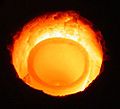Crucible facts for kids
A crucible is like a super tough cup used by scientists and engineers. It's made from special materials that can handle extreme heat without melting or reacting with what's inside. Imagine heating something to thousands of degrees Celsius – that's when you need a crucible! Scientists use them to heat different substances, often with a bunsen burner or a very hot furnace. This helps them melt metals, create new materials, or analyze what a substance is made of.
Contents
What is a Crucible For?
Crucibles have a very important job: holding things while they get super hot! This is key for many cool scientific processes, like:
- Melting metals: Turning solid metals into a liquid.
- Making new stuff: Combining different elements under heat to form brand new materials.
- Figuring out what's inside: Burning off parts of a sample to see what's left behind.
Because crucibles must stand up to intense heat, they are made from materials that won't melt easily and won't react with other chemicals.
Why Are Crucibles So Strong?
Crucibles are built to be incredibly tough! They are often made from:
- Porcelain: This is a type of ceramic, similar to what fancy dishes are made of, but much stronger and able to resist heat better.
- Non-reactive metals: These are metals that don't easily mix with other chemicals, even when they are very hot. Long ago, platinum was one of the first metals used for crucibles because it's super stable. Today, metals like nickel and zirconium are also used.
- Graphite: This is a form of carbon, like the lead in your pencil, but much harder. It's often used for melting metals like gold because it can handle high temperatures and won't make the metal dirty.
The material chosen for a crucible depends on what chemicals are being heated and how hot they need to get.
How Scientists Use Crucibles Today
Crucibles are vital tools in many areas of science and industry. They let scientists and engineers do experiments and create materials that would be impossible at lower temperatures.
Melting Metals and Making New Materials
One common use for crucibles is melting metals. For example, in making silicon for computer chips, huge crucibles are used in a process called the Czochralski process. In this method, a large crystal of silicon is slowly pulled from a crucible filled with melted silicon. This creates the pure silicon "ingots" (large blocks) needed for electronics.
Crucibles are also used to create alloys. Alloys are mixtures of two or more metals, like bronze (which is copper and tin) or steel (which is iron and carbon). By melting different metals together in a crucible, new materials with special properties can be formed.
Crucibles Through History
Crucibles have been used for thousands of years! Ancient people used them to melt and clean metals like gold and silver. Even alchemists, who were like early chemists, used crucibles in their attempts to turn ordinary metals into gold.
Thomas Edison and His Crucibles
Even famous inventors like Thomas Edison used crucibles. He had them in his laboratory to try out different materials. He used them to find the best parts for his light bulbs and for many other inventions. His crucibles were very important for testing how various substances reacted when heated.
Pictures of Crucibles in Action
-
A modern crucible used to make silicon for computer chips.
-
Melting gold in a graphite crucible, showing how hot it gets!
-
Three crucibles used by the famous inventor Thomas Edison.
Learn More About Lab Tools
 In Spanish: Crisol para niños
In Spanish: Crisol para niños




